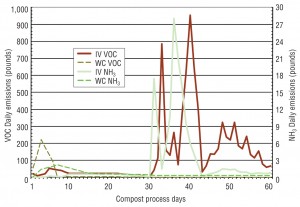More regulatory scrutiny of air emissions, combined with the ongoing need for odor control, has led more facilities to employ technologies and strategies beyond optimizing process management.
T.R. Card and C.E. Schmidt
BioCycle March 2012, Vol. 53, No. 3, p. 27
The major air emissions challenge for composting facilities in North America is odor. However, facilities operating in California and some other parts of the United States are increasingly concerned about emitting VOCs (volatile organic compounds), ammonia, greenhouse gases, ozone precursors, and even toxic compounds. Significant composting air emission reductions can occur just by implementation of more sophisticated compost management and aeration systems. By optimizing the composting process, air emissions can be reduced with no special additional hardware.
An increasing number of facilities are employing different control strategies and technologies to minimize emissions from their composting operations. The goal is to ultimately support the sustainability of composting operations with regard to minimizing off site odor and air emission impacts, or to meeting ever increasing regulatory air emission requirements. Ultimately, the “control strategy” must go beyond only air emissions during composting and include all facility activities that may be sources of emissions, including odor. Compost composition, material hold times or stockpiling protocols, materials handling and site conditions can have a significant impact on site odor and air emissions regardless of the rated effectiveness of the primary control strategy employed on site.
Available Control Strategies
Air emission control strategies range in effectiveness and cost of operation for controlling air emissions from composting operations. Table 1 provides a summary of these approaches in regards to investment, operational skill and emission control performance. Most of these control strategies can be applied to all types of solid waste streams including green waste, biosolids, food wastes and animal wastes; their effectiveness is dependent on many factors including type of waste and site operational factors. Data on control technologies in this paper are based on systems with publicly available information. The most common way to express emissions in the composting industry is to normalize them to the actual wet tonnage of initial waste, with the emission rate reported as pounds of emission per ton of waste and amendment.
Reference to a particular process or technology is not necessarily an endorsement but rather given as an example of a particular type of control strategy. Likewise the list of technologies available was intended to represent the majority of the marketplace, but is not comprehensive.
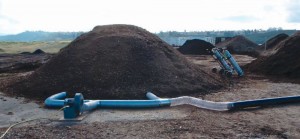
A pilot-scale test on utilizing a positively aerated static pile with a biofilter layer was conducted at the Agri Service, Inc. composting facility in San Diego County, California.
Improved Process Control
Composting is different from site to site for a variety of reasons, including feedstocks, operational procedures and climatic conditions. As such, composting is normally as much of an art as a science. Improvements in the process can be gained by paying attention to feedstock content, blending ratios of carbon to nitrogen, moisture content, pile temperature, chop size and mixing frequency. By studying key variables in the composting process, compost production can be maximized while minimizing air emissions — without the need to grossly change site operations or jump to an innovative or more expensive control strategy.
From an air emissions perspective the following are the most important process control parameters: Compost at minimum regulatory temperature; Compost at the fastest rate possible (minimize material residence time); Assure that the compost mix is completely aerobic. Obviously some of these goals are contradictory, so the optimum composting strategy may be challenging to find.
ASP With Biofiltration Layer Cover — Positive Aeration
An exciting control strategy that takes the best of “both worlds” (meaning composting with a biofilter layer as a control cover on the compost and not using a biofilter) is aerated static pile (ASP) using a layer of finished compost or screening “overs” and positive pressure aeration. The advantage of this control strategy is that little infrastructure is required, synthetic covers are not necessary, and control efficiency is achieved with the biofilter layer on the compost. Since positive aeration is used, biofiltration units are not needed. The disadvantage is that this approach may not meet the level of control required for a given site requirement.
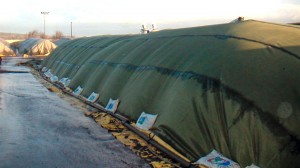
Flux chamber testing of fugitive emissions at a composting facility using the micropore (GORE®) Cover System is shown above. Flux chamber testing for emissions reductions can be done both below and above the cover.
The biofilter layer on the positive pressure ASP showed a 95 percent control efficiency for both odor and VOC emissions. Not only were reduced odor emissions achieved, but the compost had lower odor emissions on pile breakdown, thus reducing potential for odor “puff” emissions (released quickly from a source and are transient in nature) often found to be the main culprit regarding off site odor complaints from nearby neighbors. (These data were from a test at peak emissions levels, i.e., day 3 in compost cycle, and not life cycle emissions.) The key operational challenge for this method is to place the biofilter layer with the appropriate moisture level correctly on top of the pile. The biofilter layer requires moisture to biologically control the emissions, therefore the moisture content should be monitored for optimum performance. Typically, the layer is not disturbed for the duration of the compost cycle, which is one of the advantages of using a biofilter layer.
More information on this particular control strategy will be available by year’s end from a project that was recently funded by grant from the California Air Resources Board. A rigorous evaluation of this control strategy, ASP with positive aeration using a biofiltration layer, will be conducted. The grant was awarded to the California State Chapter of the US Composting Council and the project will be managed by Dan Noble of the Association of Compost Producers based in Julian, California.
ASP With Manufactured Cover — Positive Aeration
Manufactured covers (tarps) used at composting operations are made from a variety of materials such as geotextiles, laminated fabric, vinyl and micropore membranes. Use of synthetic covers is most often coupled with ASPs operated under positive pressure so that the cover system reduces emissions from a composting pile. In essence, the manufactured cover, especially the micropore fabrics, is the air pollution control device. Since the system is operated under positive pressure, scrubbing equipment such as a biofilter is not required. Therefore, the fugitive emissions from the cover itself are the only significant source of process emissions for the composting process life cycle.
The authors have tested all these materials. The vinyl and geotextile covers provide little air emissions control as they are designed to provide a simple barrier to flow. However, they can improve process performance (e.g., by retaining moisture), resulting in emissions reduction depending on the overall control strategy used. For micropore covers, the cover emissions reduction performance (based on measuring the air emissions above and below the cover) ranges from 50 percent to over 95 percent control. Micropore covers are generally marketed for reasons beyond just straight emissions control, therefore some of the cover materials are optimized for other performance metrics such as moisture and temperature management, and greater or lower porosity or air permeability. If a micropore cover system is procured primarily for emissions control, it is recommended that the cover system either have historical relevant test results, or be specifically tested for the case in question, to assure that the performance will meet expectations.
These systems have only been evaluated on the performance of the cover material itself, and do not take into account emissions from the entire system, i.e., other odor and emission sources at the composting facility. The entire system, including emissions from stored product, could be better or worse than the performance of just the cover. Note that as the efficiency of the cover system improves, the concentration of pollutants can increase under the cover, possibly further reducing compost emissions through several mechanisms (e.g., improved metabolism, sorption, or other). Therefore, with more complete composting of product, it is likely that the higher performance systems will have even better emissions reduction, as compared to an uncovered system, than what the cover performance alone suggests. Improved degradation of odor and VOC compounds under the cover can have collateral benefits for the remainder of the composting cycle, e.g., curing, product screening and compost quality.
Cover performance is measured using flux chamber testing conducted on the cover at various locations. Site emissions are determined by creating a life cycle profile for the process, including emission measurements from pile breakdown, and product storage. This plot informs the assessment of air emissions from the entire composting system.
The advantages of the positive pressure ASP with manufactured cover include possible high levels of control when used according to manufacturer recommendations, and freedom from building and maintaining a biofiltration unit. However the purchase of the covers and process control hardware is far from insignificant. In addition, the control strategy requires constant handling and maintenance of the covers.
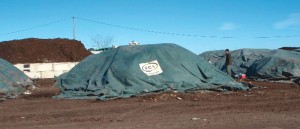
One option for negative aeration with a biofilter is an impervious cover with evenly spaced vent holes that operates under negative pressure. Oxygen is drawn through the vents into the composting material.
ASP — Negative Aeration With Biofiltration Unit
This is the most proven technology to comply with strict air pollution requirements. The normal configuration is to vent the ASP air to a biofilter for control. In addition, further control can be achieved by placing a biofilter layer or a manufactured cover over the ASP surface.
A good example of this control strategy is the South Kern Compost Manufacturing Facility located in Kern County, California, owned and operated by Synagro. (See “Cocomposting In A Restricted Air Quality Zone,” March 2011 for a facility profile.) The site operates at design capacity processing approximately 600 wet tons/day of biosolids, yet it maintains or exceeds the regulatory limit for site emissions — 80 percent control efficiency for primary (compost cycle) and secondary (curing) biofilters. The first stage of the process has a biofilter cover to further reduce emissions. These systems typically require an extensive compliance test every two years. Control efficiency for this process is considered to be the reduction of the pollutant mass before and after the biofilter.
One vendor markets an impervious cover with evenly spaced vent holes operating under negative pressure, drawing oxygen through the vents into and through the composting material, with process air treated in a biofilter. It operates under a similar principle to having a biofilter cover on top of a composting pile with negative aeration, such as that just described in Kern County. Here, the majority of the air emissions would likely come from the biofiltration unit thus determining the overall effectiveness of the control strategy.
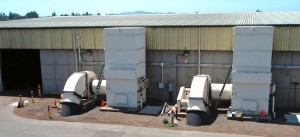
Aerated static pile systems housed in a large structure operated under negative pressure represent the maximum facility investment level for air emissions control.
Completely Enclosed ASP
Aerated static pile systems housed in a large structure operated under negative pressure represent the maximum facility investment level for air emissions control. Very few of these facilities are in operation. Air emissions from the ASP process and ambient air inside the structure are collected and scrubbed by a biofilter. The initial investment cost is high. Advantages of this control strategy include air emissions control dependent solely on the biofilter unit without limitations to the composting (no controls on the composting operation itself) and materials handling aspects of the system (front-end loaders and turning equipment operate inside the building). The design and operation of the structure is challenging due to the levels of dust and ammonia inside. Visibility is normally very limited inside the structure.
Baseline emission estimates can be achieved by measuring air emissions in the structure from representative “days” in the compost life cycle for tipping, fresh ground material, composting and curing, and used to estimate air emissions on a per ton basis for target compounds. Control efficiency can be determined by measuring fugitive air emissions from the biofilters, and computing an air emissions factor on a per ton basis for comparison to uncontrolled baseline emissions.
Air Quality Regulatory Compliance
Unfortunately, there is no standardized approach to determining regulatory compliance for air quality for composting facilities. It varies both by jurisdiction and control strategy/ technology. Because of this variability, if these systems are procured to comply with air emissions regulations, the regulatory compliance strategy needs to be thought out well in advance. Several regulatory approaches that have been used are described in this section. It is not uncommon to see multiple approaches employed at some facilities.
Existing Facility With Grandfathered Emissions Ceiling
This approach has been fairly common in California. An existing facility is given an emissions cap for the site determined by either measurement or estimation. That cap (normally called a ”baseline”) may be static or have planned decreases in the future. If the facility wants to expand, or has a decreasing cap, then composting practices that have lower air emissions levels must be implemented if site production levels are to be maintained or increased. The only concern the regulator has is actual emissions (lbs/year emitted), not control efficiency (mass controlled versus baseline mass emissions). Normally new technologies are tested to get an emission factor (lb per ton emitted or other metric) and that emission factor sets a new maximum throughput for the facility. A possible compliance strategy under this type of arrangement is to install a process with very low emissions, and then sell the emissions offsets (avoided emissions) on an emissions trading market. In California, these offsets can amount to millions of dollars per year.
Target Emissions Goals
This approach has been used for both existing and new facilities. The most common method is to use an existing industry emission factor and either meet that factor, or some fraction of it, to comply. Examples of the most common factors are the SCAQMD green waste windrow composting VOC emission factor of 3.84 pounds per ton mix and the biosolids windrow composting VOC emission factor of 1.78 pounds per ton mix. Some new facilities are required to compost at levels that are 10 to 20 percent of these numbers. Again, under this approach, the concerns are actual total emissions, not the level of emissions control.
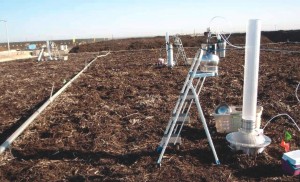
Flux chamber testing on a biofiltration unit is shown being conducted at a facility that uses a biofilter layer on compost piles (in background).
Emission Control Standards
This is a very common approach and conceptually easy to implement when there is a specific add-on control device. This method specifies that the control device shall reduce emissions by a specific percentage. The rule for new facilities in Central and Southern California typically specifies a value between 80 and 90 percent reduction by the control device for both VOC and ammonia. Normally the facilities have an emissions cap as well, and/or are required to purchase emission credits for each ton of pollutant emitted as needed per site, so assessing total site emissions also may be necessary.
When this rule is applied to complete systems that reduce emissions, such as the micropore cover systems, it is not obvious how the control efficiency should be calculated. Regulators are accustomed to just evaluating the cover control, but the true number is the total reduction in emissions as compared to an uncovered process. It is likely that the high performance micropore systems provide a system wide level of control that is higher than just the value achieved by the cover (e.g., the collateral benefits discussed earlier). This total reduction quantity is yet to be evaluated because it is a significant additional expense to operate an uncovered and covered process side-by-side and test both composting operations. The first time that this will occur (as far as we are aware) will be during the research test in California this summer on positively aerated ASPs with and without biofilter covers referenced previously.
Compliance Testing Strategies
Almost all control strategies used in a regulatory context for air quality compliance will eventually be compliance tested. These systems are difficult to test accurately because they represent large area sources, but it can be done. The compliance test will normally include, but not be limited to, traditional stack testing along with fugitive area source air emissions testing to determine control efficiency.
A detailed discussion of air emissions testing methods was provided in our article, “Air Emissions Assessment Technologies,” in the March 2011 edition of BioCycle. When undergoing a compliance test, it is important that the test “proves what you already know” and is not used to determine what you don’t know. Compliance tests are public and can have severe negative implications if the test fails. Therefore if there is any uncertainty at all about what the emissions are, it is recommended that testing occur prior to the compliance test to bring the level of process emission knowledge to “prove what you already know.”
Unfortunately, the cost of air emissions testing of compost processes is not insignificant, so testing is only done when absolutely necessary. However, if a composting facility is in a severe air quality regulatory environment, it is necessary to know present and likely future air emissions with a high degree of accuracy in order to have a sustainable business.
Conclusions
A variety of control strategies are successfully used today to meet site standards for air emissions. Evaluating the various control options requires a rigorous evaluation of existing air emissions and performance data, and also a sizing-up of the strategy with regard to how the strategy will be implemented at the site, and how it will work. Some site operators like applying a technology to the compost surface such as a cover or a biofilter layer, where others prefer to control site emissions at the point of origin. Then there is the issue of owning and operating a biofiltration unit, which requires a good design and serious attention to operational details. Again, some site operators invest in gas collection and scrubbing, whereas others run from the thought of a biofiter unit.
Despite all the variations, one thing is certain: the business of composting is not ”prescriptive.” There are many approaches in terms of technologies and/or control strategies to get the job done with regard to the management and operation of composting facilities. Selecting and operating the “right fit” control strategy for your site is one of the important pieces of the puzzle for sustainability of the industry.
Tom Card is a civil engineer with extensive experience in performing air emission estimates from complex sites. He operates a consulting business, Environmental Management Consulting, out of Enumclaw, Washington and can be contacted by email at trcard@earthlink.com. Chuck Schmidt is a Ph.D. analytical chemist with expertise in performing air emission assessments. He operates a consulting business, CE Schmidt Environmental Consulting, out of Red Bluff, California, and can be reached at schmidtce@aol.com (www.ceschmidt.com).



